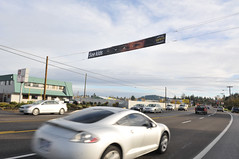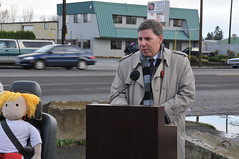Portland Mayor Sam Adams led a press conference today to officially launch the Bureau of Transportation’s new High Crash Corridor Safety campaign. Standing under a newly unveiled banner that stretches all the way across SE Foster Road (one of the city’s most dangerous), Adams said, “This street functions in many ways like a freeway, but it’s not.”
The new “See Kids” banner, with the eyes of a small child staring down on traffic, is PBOT’s educational component of the new safety campaign that focuses on high speed arterials where there are a higher than average rate of fatal and injury crashes. “There are reasons why businesses use banners on busy streets like this,” Adams told the crowd, “Because it draws attention… and it works.”
Adams said the goal of the campaign is to reign in some of the freeway-like driving that occurs on roads like Foster. “We want people to slow down and remember that there are schools and senior centers nearby.”
Jason Tell, ODOT’s Regional 1 manager, announced that they’ve committed $14 million over the next 3-4 years specifically focused on high crash corridors. Adams added that PBOT is upping their investment in improvements that make biking and walking safer, saying that over the next three years, he’ll allocate $20 million to infrastructure improvements and other programs.
To show that enforcement is a big piece of the safety puzzle, Portland Police Bureau Traffic Division Captain Todd Wyatt also spoke at the event. He showed a bit of passion and told the crowd, “Two people were killed this week on Portland’s roads… And that’s two too many!” He shared the story of two kids walking to school in North Portland this month who were hit by a motor vehicle operator while crossing NE 15th at Rosa Parks.
“That driver isn’t a bad person,” Wyatt said, “But the driver has room for improvement and that’s what we’re here to talk about.”
“This is the kind of thing we need out here… It makes people more aware of the crisis.”
— Nick Christensen, neighborhood resident
During a Q & A session that followed the formal remarks, I asked ODOT’s Jason Tell if his agency plans a policy or programmatic response to the dramatic uptick in fatal crashes involving people walking on Oregon roads this year (up 80% over 2009). Tell said that “Everyone should be concerned” about those statistics and added that they are “obviously tragic and avoidable.”
Tell referenced the $14 million ODOT will invest in intersections and pedestrian crossings. But, Tell said, the “educational aspects” of the effort might be even more important:
“We are doing a lot We really are pleading with the public and those who use the system — and that means everybody, whether you’re in a car, on your bike, or walking — everyone has to pay attention and be seen and look out for each other. We’re really going to be on that message as much as we can, but in the end we really need the people who are using the transportation system to do their part as well.”
As for specific things ODOT plans to do in response to the pedestrian fatality uptick, Tell told me they still need to get back all the crash analysis and investigations to see how the fatalities occurred and who/what was at fault before they can put together a targeted response in terms of investments and programs.
Lents Neighborhood activist Nick Christensen also came out this morning. He was excited to see this happening in his neighborhood. “This is the kind of thing we need out here… It makes people more aware of the crisis. And it is a crisis. 33,000 people dying [in traffic crashes in America], that’s a crisis! And people are dying unnecessarily.”
PBOT plans to install a total of 10 banners on roads they’ve identified as the most dangerous corridors. The total cost of the banner program is $75,000 over two years.





